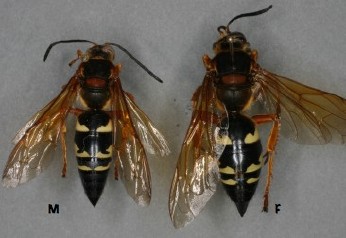

There may have been times where you notice a large scary looking wasp and thought “what is that giant thing?”. Your next thoughts were probably something like “I’d really hate to get stung by it.” One of the several types of wasps you can find in central Florida is called a “Cicada Hawk” or “Cicada Killer”. Its scientific name is Sphecius speciosus. It is found in various southern U.S. states as well as northern Mexico and parts of South America.
Right off the bat I must tell you that although this wasp can sting people it only does so if directly threatened (or stepped on). It will usually go out of its way to avoid contact with humans. Not only that, only the females can sting. The females are larger than the males.
As their name implies, they hunt and feed on cicadas. As you probably know, cicadas are that winged insect that sit in trees and make that constant buzzing sound you hear in the summer time. Well, this particular wasp has evolved to feed exclusively on this bug. The female uses it stinger to stun the cicada and then takes the insect back to its nest to devour. The nest is usually located in the ground. The wasp also will lay eggs on a cicada and seal off part of its nest for its offspring to grow. They feed on the dead cicada.
Many people who have actually been stung by this wasp say it isn’t as bad as other stings and feels mainly like a pin prick. If you are anything like me, you intend to never find out.
The cicada is a large insect. So the cicada killer had to grow to be large as well. It has to carry this cicada, which is usually larger than the wasp, hundreds of yards back to its nest. They will often have to make several stops of the way to rest. So, if you ever see a large wasp carrying a bug larger than itself, you can bet that it very well could be a cicada wasp.
If you stumble on a burrowed nest of cicada killer wasps and want it gone, we suggest you call a pest control specialist. Like we said, if the nest is threatened they will attack.
